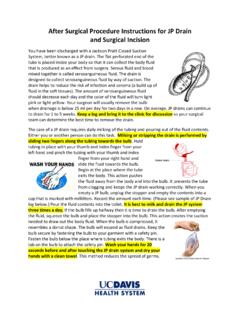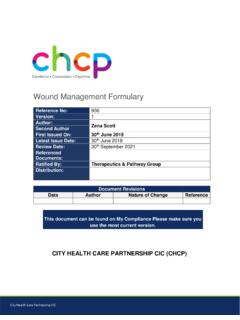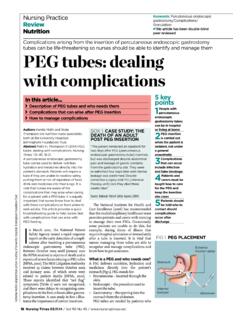Transcription of Care for Your Open Wound, or Draining Abscess
1 DSA My Doctor Online General Surgery Last updated 3/7/13 Care for Your Open wound , or Draining Abscess Careful attention will help your wound heal smoothly. Keep the area clean and protected from further injury. Gentle heat will increase blood flow, and speed healing. A warm, wet towel applied for 20 minutes several times a day is enough. Be careful not to burn yourself. Do not let your wound dry out. This could damage the delic ate new cells th at are growing. Cleaning your hands and the surrounding skin with mild soap and warm water is usually enough. A daily shower with all bandages removed will help prevent buildup of debris that would harbor the growth of more bacteria. Your doctor will tell you if full st erile technique is necessary. Wet to Dry dressings : Three times a day rem ove bandages and clean the wound . You may sh ower at this time.
2 Gently clean out all loose debris with a Q -tip or washcloth. If your wound is not dr aining much, moisten a piece of gauze with salin e, and gently place gauze into the deepest part of the wound . Do not pack tightly, but do keep th e wound edges from touching, so that the wound can heal from the i nside out. If wound is Draining much, pack with dry gauze to absorb excess moisture. For copious drainage, sanitary pads can be a very absorbent, cushiony, and inexpensive dressing. wound drainage may be clear, cloudy, pink, yellow, dark red, or brown. It should gradually become clear er, and be produced in smaller amounts. A small amount of blood is normal. Your doctor may recommend wound gel . This can be changed either once or twice a da y. Clean the wo und as described above, then put a th in layer of gel on dry gauze to place into the wound .
3 A very small wound can be treated with antibiotic ointment and dry gauze or a band-aid, changed as needed. You should notice the wound shrinking, with less discomfort and discharge over time. Report to your doctor if: 1. There is increasing pain, swelling, redness, foul odor, or drainage. 2. You feel ill, or start ha ving fevers over 100F.
















